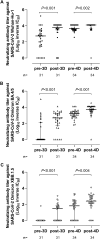Functional antibody responses targeting the Spike protein of SARS-CoV-2 Omicron XBB.1.5 in elderly nursing home residents following Wuhan-Hu-1-based mRNA booster vaccination
- PMID: 38789475
- PMCID: PMC11126592
- DOI: 10.1038/s41598-024-62874-7
Functional antibody responses targeting the Spike protein of SARS-CoV-2 Omicron XBB.1.5 in elderly nursing home residents following Wuhan-Hu-1-based mRNA booster vaccination
Abstract
The immune effector mechanisms involved in protecting against severe COVID-19 infection in elderly nursing home residents following vaccination or natural infection are not well understood. Here, we measured SARS-CoV-2 Spike (S)-directed functional antibody responses, including neutralizing antibodies (NtAb) and antibody Fc-mediated NK cell activity (degranulation and IFNγ production), against the Wuhan-Hu-1, BA.4/5 (for NtAb), and Omicron XBB.1.5 variants in elderly nursing home residents (n = 39; median age, 91 years) before and following a third (pre- and post-3D) and a fourth (pre- and post-4D) mRNA COVID-19 vaccine dose. Both 3D and 4D boosted NtAb levels against both (sub)variants. Likewise, 3D and 4D increased the ability of sera to trigger both LAMP1- and IFNγ-producing NK cells, in particular against XBB.1.5. In contrast to NtAb titres, the frequencies of LAMP1- and IFNγ-producing NK cells activated by antibodies binding to Wuhan-Hu-1 and Omicron XBB.1.5 S were comparable at all testing times. Stronger functional antibody responses were observed in vaccine-experienced participants compared to vaccine-naïve at some testing times. These findings can contribute to identifying a reliable correlate of protection in elderly nursing home residents against severe COVID-19 and inform future vaccine strategies in this population group.
© 2024. The Author(s).
Conflict of interest statement
The authors declare no competing interests.
Figures








Similar articles
-
Estimating SARS-CoV-2 Omicron XBB.1.5 Spike-Directed Functional Antibody Levels From an Anti-Receptor Binding Domain Wuhan-Hu-1-Based Commercial Immunoassay Results.J Med Virol. 2025 Jan;97(1):e70130. doi: 10.1002/jmv.70130. J Med Virol. 2025. PMID: 39812228 Free PMC article.
-
Antibody-dependent NK-cell and neutralizing antibody responses against the Spike protein of Wuhan-Hu-1 and Omicron BA.1 SARS-CoV-2 variants in vaccinated experienced and vaccinated naïve individuals.J Med Virol. 2023 Jul;95(7):e28900. doi: 10.1002/jmv.28900. J Med Virol. 2023. PMID: 37403730
-
SARS-CoV-2-Spike T-cell response after receiving one or two Wuhan-Hu-1-based mRNA COVID-19 vaccine booster doses in elderly nursing home residents.J Med Virol. 2024 Jul;96(7):e29790. doi: 10.1002/jmv.29790. J Med Virol. 2024. PMID: 38994662
-
Comprehensive Analysis of Omicron Subvariants: EG.5 Rise, Vaccination Strategies, and Global Impact.Curr Drug Targets. 2024;25(8):517-525. doi: 10.2174/0113894501296586240430061915. Curr Drug Targets. 2024. PMID: 38726782 Review.
-
Should SARS-CoV-2 serological testing be used in the decision to deliver a COVID-19 vaccine booster? A pro-con assessment.Vaccine. 2024 Nov 14;42(25):126184. doi: 10.1016/j.vaccine.2024.126184. Epub 2024 Aug 3. Vaccine. 2024. PMID: 39097440 Review.
Cited by
-
Estimating SARS-CoV-2 Omicron XBB.1.5 Spike-Directed Functional Antibody Levels From an Anti-Receptor Binding Domain Wuhan-Hu-1-Based Commercial Immunoassay Results.J Med Virol. 2025 Jan;97(1):e70130. doi: 10.1002/jmv.70130. J Med Virol. 2025. PMID: 39812228 Free PMC article.
-
Fc-effector functional antibody assays for SARS-CoV-2 variants of concern.Front Immunol. 2025 May 20;16:1571835. doi: 10.3389/fimmu.2025.1571835. eCollection 2025. Front Immunol. 2025. PMID: 40463385 Free PMC article.
References
MeSH terms
Substances
Supplementary concepts
Grants and funding
- FIS, PI21/00563/Instituto de Salud Carlos III
- FIS, PI21/00563/Instituto de Salud Carlos III
- FIS, PI21/00563/Instituto de Salud Carlos III
- FIS, PI21/00563/Instituto de Salud Carlos III
- FIS, PI21/00563/Instituto de Salud Carlos III
- FIS, PI21/00563/Instituto de Salud Carlos III
- FIS, PI21/00563/Instituto de Salud Carlos III
- FIS, PI21/00563/Instituto de Salud Carlos III
- FIS, PI21/00563/Instituto de Salud Carlos III
- FIS, PI21/00563/Instituto de Salud Carlos III
- FIS, PI21/00563/Instituto de Salud Carlos III
- FIS, PI21/00563/Instituto de Salud Carlos III
- 202020E079 y CSIC-COVID19-028/Fundación General CSIC
- 202020E079 y CSIC-COVID19-028/Fundación General CSIC
- 202020E079 y CSIC-COVID19-028/Fundación General CSIC
- 202020E079 y CSIC-COVID19-028/Fundación General CSIC
- 202020E079 y CSIC-COVID19-028/Fundación General CSIC
- 202020E079 y CSIC-COVID19-028/Fundación General CSIC
- 202020E079 y CSIC-COVID19-028/Fundación General CSIC
- 202020E079 y CSIC-COVID19-028/Fundación General CSIC
- 202020E079 y CSIC-COVID19-028/Fundación General CSIC
- 202020E079 y CSIC-COVID19-028/Fundación General CSIC
- 202020E079 y CSIC-COVID19-028/Fundación General CSIC
- 202020E079 y CSIC-COVID19-028/Fundación General CSIC
- PID2020-115506RB-I00 (HTR)/Ministerio de Ciencia e Innovación
- PID2020-115506RB-I00 (HTR)/Ministerio de Ciencia e Innovación
- PID2020-115506RB-I00 (HTR)/Ministerio de Ciencia e Innovación
- PID2020-115506RB-I00 (HTR)/Ministerio de Ciencia e Innovación
- PID2020-115506RB-I00 (HTR)/Ministerio de Ciencia e Innovación
- PID2020-115506RB-I00 (HTR)/Ministerio de Ciencia e Innovación
- PID2020-115506RB-I00 (HTR)/Ministerio de Ciencia e Innovación
- PID2020-115506RB-I00 (HTR)/Ministerio de Ciencia e Innovación
- PID2020-115506RB-I00 (HTR)/Ministerio de Ciencia e Innovación
- PID2020-115506RB-I00 (HTR)/Ministerio de Ciencia e Innovación
- PID2020-115506RB-I00 (HTR)/Ministerio de Ciencia e Innovación
- PID2020-115506RB-I00 (HTR)/Ministerio de Ciencia e Innovación
LinkOut - more resources
Full Text Sources
Medical
Research Materials
Miscellaneous

